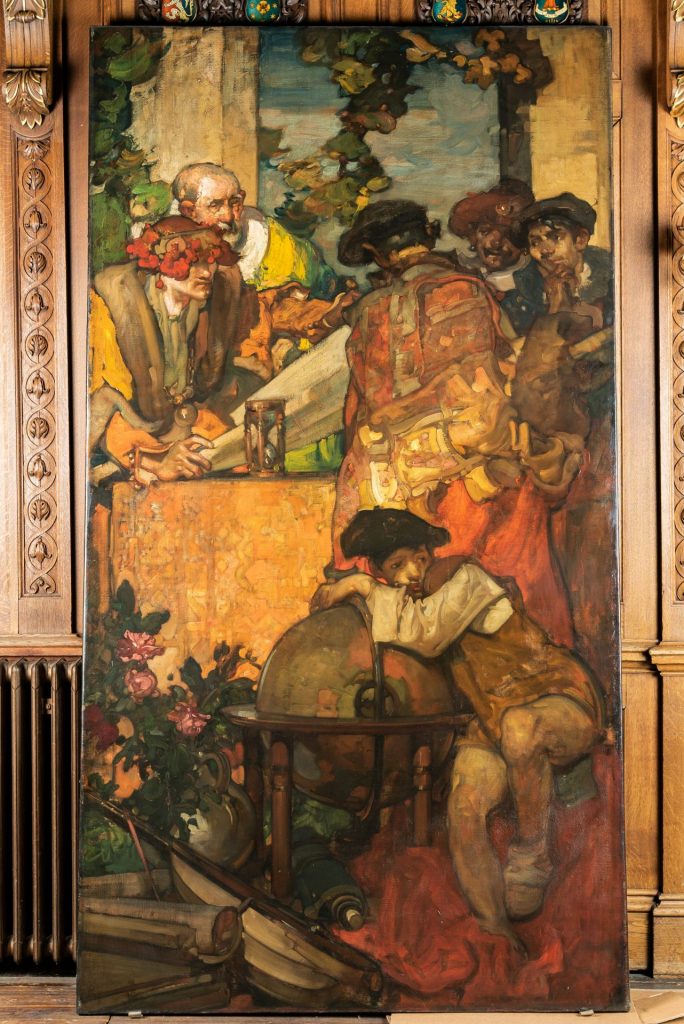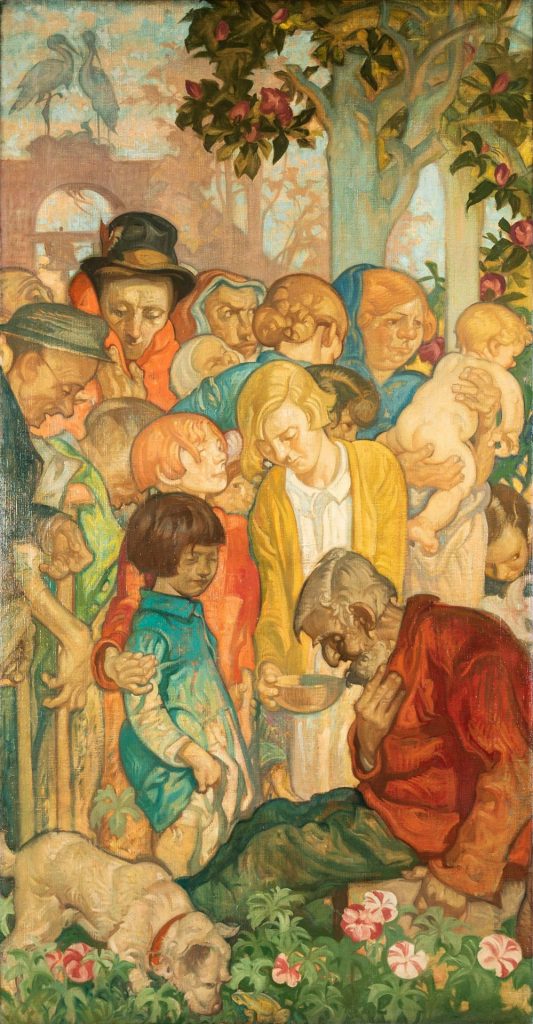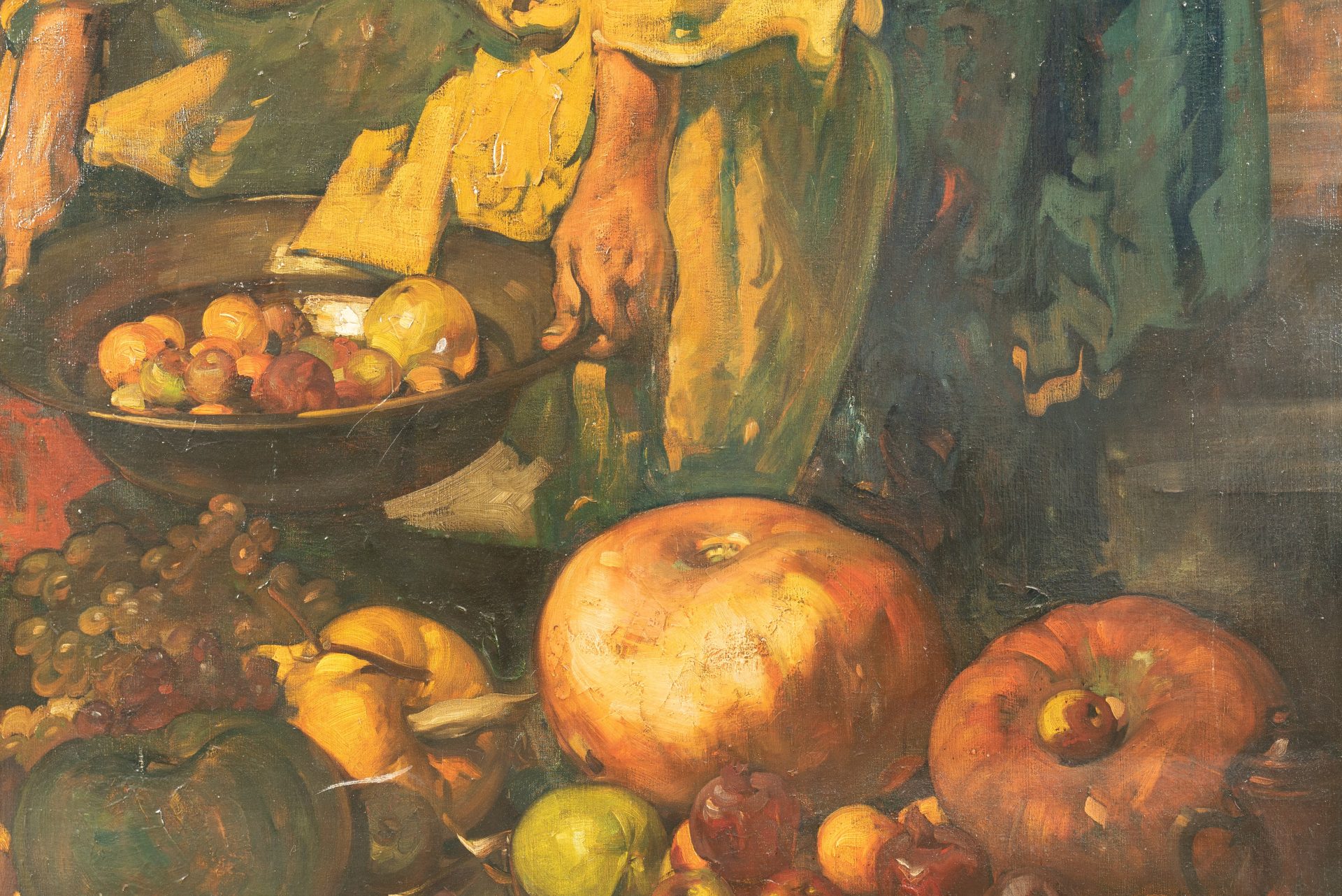By the spring of 1909 the ancient City of London Livery company, the Skinners, had become distinctly irritated with the artist Frank Brangwyn and expressed their extreme disappointment at his “further failure to complete his work”.
They had a point. The company had commissioned him in 1902 to paint a series of murals depicting a colourful past stretching back to 1327 when they were granted a lucrative Royal Charter to trade in fur.
The understanding was that he would paint 11 murals that would represent the “stir and colour of the long-drawn Pageant of the Guild” with two murals to be completed within 12 months and the rest in five years, and was to be paid £4,000.
But by 1908 only seven murals were in position. It got worse. In fact, Brangwyn (1867-1956) only managed to complete the project, admittedly with two extra commissions, by 1930, feigning illness and over-work on at least two occasions and admitting to having help from his assistants.
Better late than never. Eight of his huge, vigorous murals are now filling the walls of the Ditchling Museum of Art + Craft in East Sussex, the village where lived with his wife, Lucy, from 1917 until his death in 1956, while Skinners’ Hal,l an elegant 17th-century house built in the City of London, undergoes restoration.
The murals were designed to sit a neck-cricking three metres high in the banqueting hall so to come face to face with them in Ditchling’s tiny space is an absolute showstopper with their rich, glowing colours “put together with cheerful optimism” as one art historian put it. In fact, almost too powerful. You have to stand on the opposite wall of the gallery to take them in. Maybe the description by a critic of one of the murals – that of the English trader and privateer in Departure of Sir James Lancaster for the East Indies, 1594 – when it was hung at the Royal Academy in 1904 captures its impact. “It made as much disturbance as a whale would make in a river full of trout and perch,” he wrote.
His city patrons would not have tolerated any kind of social realism or political painting; they wanted scenes that reflected their history from the time they were granted their wealth and indeed to celebrate their colonial aspirations. For centuries they instinctively believed in the superiority of the Anglo-Saxon mission to improve the world, but today operate as a not-for-profit organisation sponsoring several charities.
Brangwyn himself was at great pains to represent the dignity of native people, however poor, and introduced scores of ordinary people into his work, insisting that “history never records the poor”.
The subjects of the series of paintings end with the enthronement of William and Mary in 1689 and involve historical figures that mean little today but obviously play a part in the story of the Skinners, such as The founding of Tonbridge School by Sir Andrew Judd, 1553, which features the 16th-century merchant and Lord Mayor of London but is centred around a young pupil. In Lord Mayor Pilkington entertaining King and Queen, 1689 the wealthy merchant of the piece is pushed to the background of a scene bustling with lush imagery of working men delivering great bowls of fruit, mighty pomegranates and barrels of wine to the great man’s table. It is a scene full of life, colour and vigour in which, as a critic suggested, “He finds in the corduroy and fustian of the great-shouldered worker of our day a romance as marked as the would-be romancers try to set about the buccaneer or warrior class.”

There is a similar crowded intensity about Education 1689, painted between 1912 and 1937, and Harmony (c1903), in which his housekeeper, Lizzie Peacock, is thought to have posed for some of the musicians. She would also pin up his notes by the village crossroads when he wanted someone from the village to pose for a painting. One willing volunteer was the actor Donald Sinden, he of the orotund speech, whose father was the village chemist and who posed for Education.

Not all were impressed. One critic wrote: “It is perhaps safer to suggest that on the walls of the Skinners’ Hall Mr. Brangwyn gives us his unclothed, clamorous temperament, not his clothed and cloistral personality” and exhorted “Think what has been done in the wall-painting way: think of Botticelli’s two Tornabuoni frescoes, now on the staircase at the Louvre, and the undying message of grace and loveliness that the personality of Botticelli, delicate as a bed of wet violets in the springtime, conveys to us.”
Brangwyn, however, was definitely not of the wet violet school of art, which is precisely why these mighty murals have such potency. He rarely went out of his way to please, followed no fashions artistically, regarded as a radical one minute, pilloried as an establishment figure the next. He never tried to conform and took pride in resisting trends, rather irritably claiming that art was an occupation – just a job – rather than a vocation, and preferring to be called a designer rather than an artist.
Although hugely accomplished as a painter and in drawing, he eschewed the easel for decorative art and large-scale murals. “Easel painting enfeebles the mind,” he grumbled. “A maker of toys, pathetic in its want of dignity. Let us have walls that we may paint over them.”
And that’s what we find in Ditchling, strong arrangement bursting with life and people, with carefully considered colours, all of which he argued could only be made with as much planning, trial and error as an architect uses to design a building.
His work was branded by the artist Wyndham Lewis as “abysmal inexcusable middle class”.
If not middle class exactly, he was definitely born into a cosmopolitan world. His parents lived in Bruges, Belgium, where he worked as an apprentice to his father and where the biggest single collection of his works is gathered in the Arentshuis. As a young man he sailed to Spain as a crew member and visited South Africa.
His travels to North Africa and Turkey almost certainly inspired him to use a brighter palette in two of his later Skinners murals, Education and Charity (1937).
When he moved back to England he became an enthusiast for the Arts and Crafts movement and was influenced by its leading lights, Arthur Mackmurdo and William Morris. By 1912 he was well known in France and awarded Chevalier of the Légion d’Honneur.
The exhibition has a few well-chosen exhibits that hint at his prodigious output and, incidentally, help to explain why he dallied so long over the Skinners project. It could be that he was not the best organised, but fundamentally he couldn’t say no to an idea. Instead of dipping his brush into the paint for the murals he allowed himself to be interrupted by a dizzying array of work, producing 73 oils, 200-plus watercolours and drawings, 304 etchings, 73 woodcuts, lithographs, woodcuts, carpets and jewellery. He even designed the street decorations for George V’s coronation.
He represented Britain at the Venice Biennale, joined the Vienna Secessionist movement and was the first artist to be given a retrospective exhibition at the Royal Academy during his lifetime. He designed the fabulous mosaic that soars over the nave of St. Aidan’s Church, Leeds, made murals for the Canadian Railway offices in London, and carried out big projects in the US and Canada.
If that wasn’t enough, while the poor Skinners were fretting over delivery of the last murals, he was also working on his most spectacular murals, which were commissioned to commemorate the first world war. A full-size panel gives an indication of the ambition of the project, known as the British Empire Panels, which comprised 16 works and covered 3,000 sq ft, but they were deemed too colourful for the House of Lords where they were supposed to go – more at home in a nightclub than Westminster, wrote the Daily Mail – and ended up in Brangwyn Hall, Swansea, Wales.
His draughtsmanship and technical skill is evident in drawings including Cannon Street Station (1913), which captures all the fuss, noise and smoke of the dingy station, with hop-pickers climbing on board to spend the summer working in Kent, and Demolition of the Post Office (1913), with small figures clambering over the debris of destruction and St Paul’s Cathedral looming proudly behind the girders and the dust.
The small display of works includes pots, jugs, a dish designed for Royal Doulton, and one or two sketches like the etching Bridge at Espalion (1919), a small town in the Occitane region of France, which showed tanners on their knees hard at it, washing skins with the medieval bridge arching behind them.
A clutch of moodily erotic photographs of naked women are tucked away. They serve as an acknowledgement that he was not at ease with the female form, though there is a tiny sketch of a troupe of nudes drawn in the manner of a (pre-internet) schoolboy’s naive imaginings of the female form and one that rather proves his own point that “a woman’s backside is no more important than the melon or the goat”.
So, a difficult man to pin down. The contrast between the charming Royal Doulton octagonal serving dish with its floral pattern, the uncompromising black and white of the Demolition of the Post Office and the bold creativity of the murals could hardly be more different, but then he was a man who went his own way, ignoring trends, with no affinities to any period, sometimes irritably, invariably confidently – as a long film about his career demonstrates – and latterly somewhat reclusively in Ditchling after the death of his wife in 1924.
He summed it all up thus: “An artist’s function is everything: he must be able to turn his hand to everything, for his mission is to decorate life… he should be able to make pots and pans, doors and walls, monuments or cathedrals, carve, paint, and do everything asked of him.”
Frank Brangwyn: The Skinners’ Hall Murals, until October 16 2022
Richard Holledge has worked for the Telegraph, Times and Independent (among others), and writes about the visual arts for the Wall Street Journal, Gulf News, FT and New European











